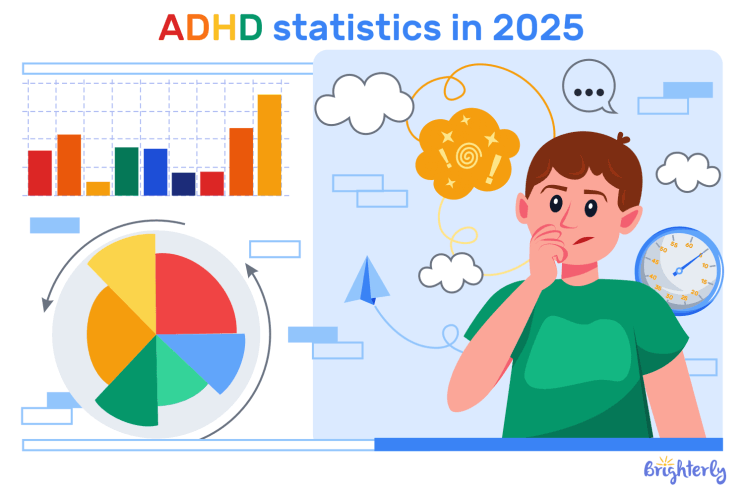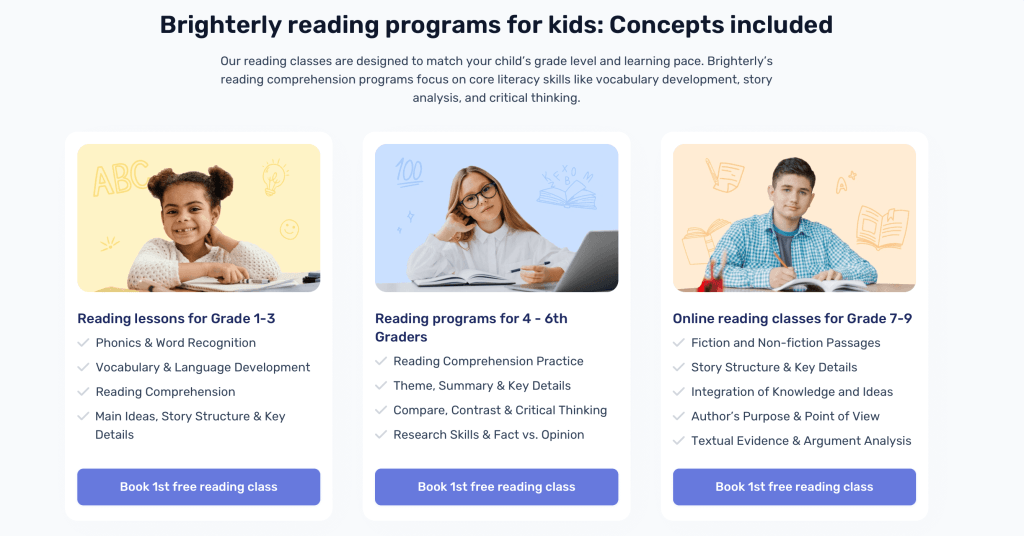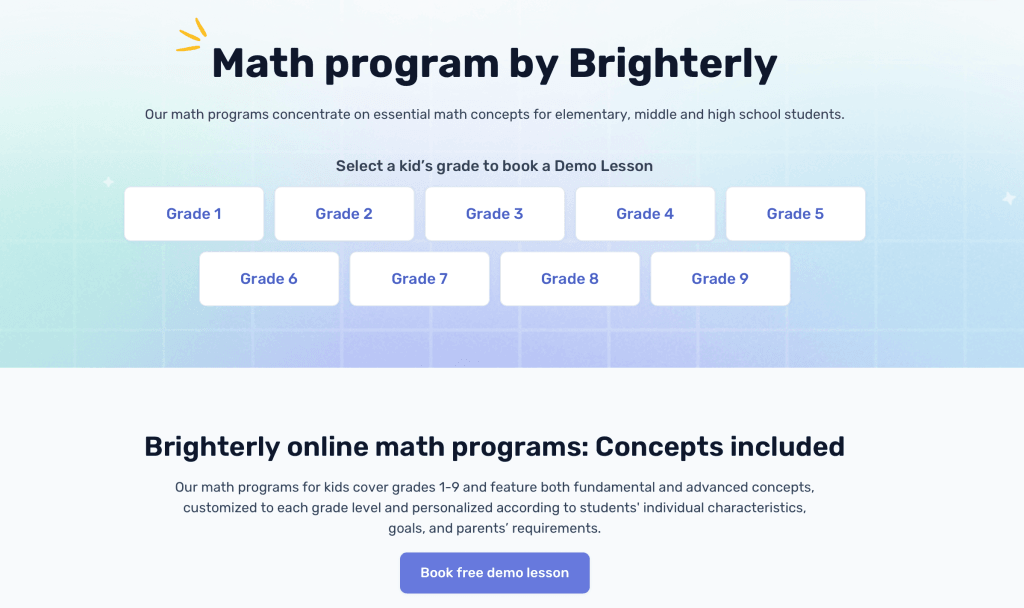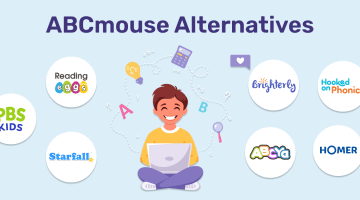ADHD Statistics in 2025: Global and US Trends Among Children
reviewed by Marvi M. Andres
Updated on October 11, 2025
Did you know that Attention Deficit Hyperactivity Disorder (ADHD) is one of the most common disorders among children and adolescents? Over the past four years, the rate among US children increased from 8% to 12%, meaning one in nine is diagnosed with ADHD. Among adults, one in seventeen lives with ADHD. In this article, I present the ADHD statistics 2023-2025 and explain what these numbers may reveal.
Key points
- This article presents the latest ADHD statistics 2023-2025 for children and adults in the US and worldwide.
- I examine the percentage of people with ADHD among children and adults, how these numbers have changed over recent years, and key trends.
- Differences by age, gender, and region are highlighted, including various US states.
- Global ADHD prevalence statistics show that Caribbean countries have the highest ADHD prevalence at over 4%, with the ADHD rate in the US half of that.
- As a teacher, I also explain what these numbers mean for learning and child development, and how platforms like Brighterly can help parents and children learn effectively and easily.
What percent of the US has ADHD?
The percent of the US population with an ADHD diagnosis is 6%, with roughly 15 million adults and 7 million children affected.
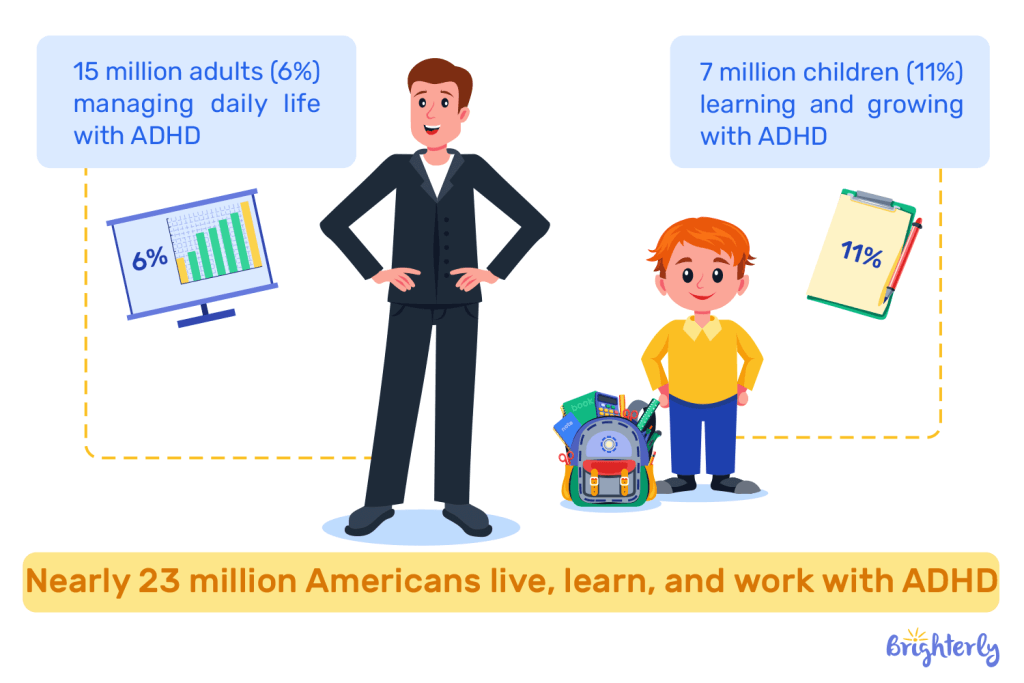
What percent of kids have ADHD in the US?
The percentage of kids in the US who have an ADHD diagnosis is more than 11%. On average, boys receive the diagnosis nearly twice as often, as their hyperactive and impulsive symptoms are much more noticeable, while in girls, ADHD often shows up as inattentiveness and is easier to overlook.
ADHD statistics men vs women
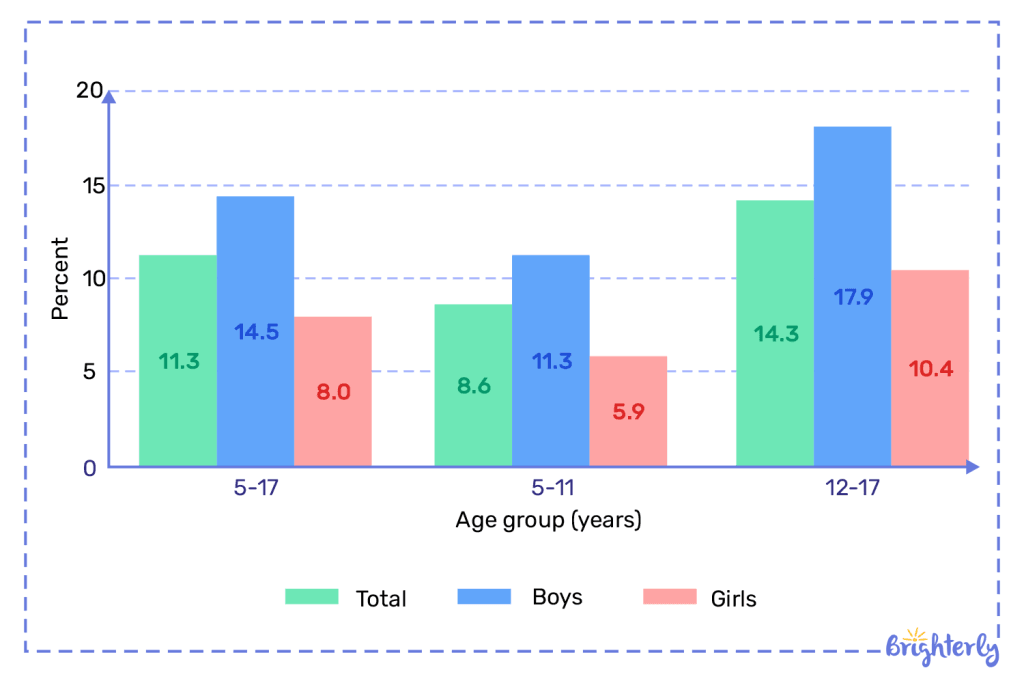
Moreover, children of European and African American descent are diagnosed with ADHD nearly twice as often as their Asian peers. The reasons are not fully understood, though cultural factors and differences in how symptoms are reported by parents are likely to play a role. Kids with ADHD statistics continue to rise each year, likely because nowadays parents and educators are more aware and notice symptoms earlier.
Why ADHD statistics matter: From symptoms to mental wellbeing
Before we dive into the detailed statistics about ADHD, I want to share why this article matters. ADHD (Attention Deficit Hyperactivity Disorder) is a behavioral neurodevelopmental condition that affects attention, focus, impulsivity, and organization. Having trouble concentrating isn’t a sign of laziness – it means that the brain works a little differently.
Millions of adults worldwide struggle with forgetfulness, distractibility, and other inattentive symptoms, which can worsen mental health and lead to stress, low self-esteem, or frustration. Now imagine if these adults were children today – everything could be different! Modern educational programs and platforms provide structured treatment and thoughtful care, helping children manage difficulties early so they can confidently learn, grow, and thrive from preschool through school and into adult life.
Note: If you’re looking for a platform that attentively supports your child’s learning, I wholeheartedly recommend Brighterly – a solution designed to nurture focus, confidence, and long-term success with a reading program and math program.
Statistics ADHD: How to improve reading/math skills with Brighterly?
As a teacher, I can say that Brighterly reading and math tutoring platform is one of the most thoughtful learning resources I’ve worked with. Every lesson is fully adapted to your child’s pace and learning style. The heart of the program is its tutors – certified, caring, and skilled in supporting children who may struggle. Moreover, lessons are interactive, flexible, and designed to keep kids engaged and confident.
- Reading program. In Brighterly, reading isn’t just about sounding out words – it’s about understanding them. Kids learn to think through the text, retell stories, and share their ideas, naturally improving writing, speaking, and critical thinking. Reading worksheets and interactive activities make lessons interesting and supportive, especially for children with ADHD. For more tips, check out the article on ADHD and reading.
- Math program. Brighterly’s 1-on-1 math lessons let teachers guide each child step by step, clarify tricky concepts, and adapt the pace to their needs. They use clever analogies, animated slides, and interactive math worksheets, and kids grasp concepts and start to love math, which is particularly helpful for children with ADHD and math challenges.
Note: Brighterly is made for kids in grades 1-9, and each lesson follows US curriculum standards. With a certified tutor guiding them, your child will boost school performance.
What are the statistics of ADHD by state?
ADHD percentage among children across the US ranges from 5% to 16% depending on the state. Louisiana, Rhode Island, and South Carolina have the highest rates of diagnosed ADHD among children aged 3-17, while California reports the lowest.
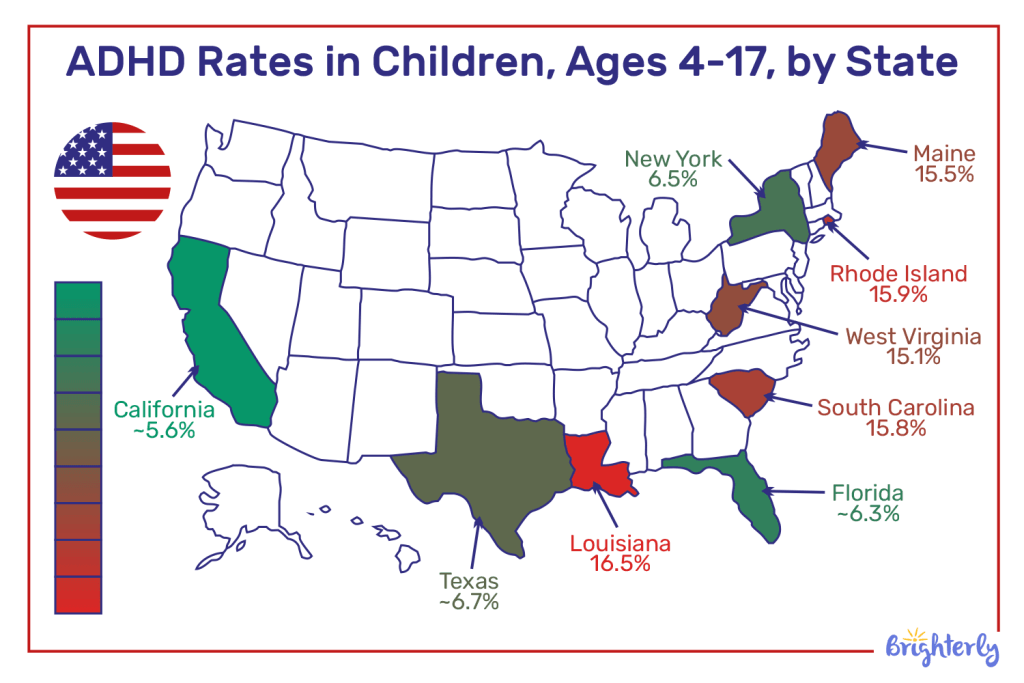
However, these numbers don’t always reflect the actual prevalence. Keep in mind that they often indicate how aware doctors, parents, and teachers are, as well as the availability of healthcare services in each state.
ADHD statistics for kids by year in the US
I’d like to share some trends in kids’ statistics on ADHD. Over the past seven years, the number of ADHD diagnoses among children in the US has been slowly going up. According to Center for Disease Control and Prevention (CDC), in 2016-2018, about 9.4% of kids aged 3 to 17 had a confirmed diagnosis. That’s around 6.1 million children.
In 2019, there was a small drop to 8.8% (about 5.7 million kids). However, since 2020, the national numbers have risen again: at that time, 11.3% of children were diagnosed with ADHD. Today, the figure is occurring at an even higher rate, reaching about 12%, or roughly 7.8 million children in the US.
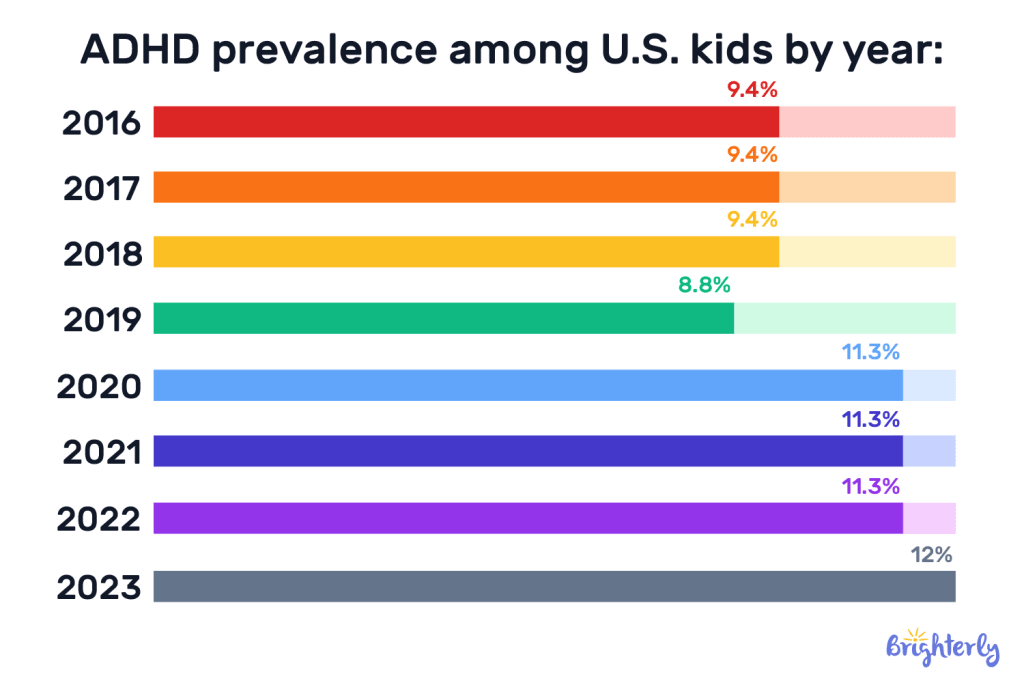
ADHD statistics among adults by year in the US
What percentage of people have ADHD in 2021 |
What percentage of people have ADHD in 2022 |
What percentage of people have ADHD in 2023 |
|
| % of adults | ~0.7% | ~0.8% | ~0.9% |
| Number of people | ~1.8 million | ~2.1 million | ~2.4 million |
Source: American Psychiatric Association
*ADHD statistics 2024 are not yet available.
ADHD stats for adults over the last 5 years
Between 2021 and 2024, more than 1 million additional Americans were diagnosed, or nearly 22,000 new cases each month. Over this period, the trends in ADHD were negative, with the overall frequency of ADHD diagnoses surging by 27%.
How many people in the world have ADHD?
Country-wise, Haiti has the highest share of teens and adults diagnosed with ADHD at 4.6%. among countries, the highest ADHD rate is observed in Haiti (4.6%), Iran (3.5%), Australia (3.4%), Algeria (3.4%, and Brazil (2.7%). The prevalence in the United States is estimated at 2.2%, above Canada (1.9%) and the United Kingdom (1.4%).
As for the countries with the lowest ADHD rates, according to known data, these are Romania, Poland, and Iraq (up to 0.5%).
Note: However, readers should know that, unfortunately, there is no comprehensive, large-scale study that gives a clear and complete picture of the full ADHD spectrum at this time. These figures come from the most recent publications and rather reflect where ADHD is actually being tracked.
ADHD statistics worldwide
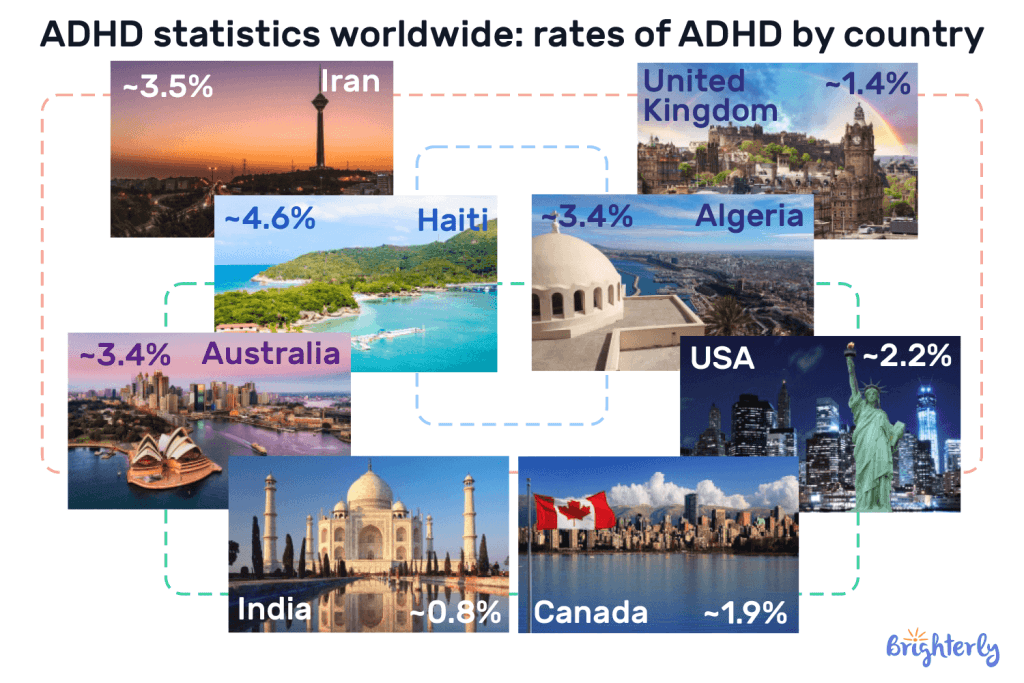
Source: Medical Journal of The Islamic Republic of Iran (MJIRI)
ADHD statistics worldwide by age
When it comes to the ADHD rate by age group, children aged 3 to 11 years rank first, with a prevalence of 7.6%. Among adolescents (12-18 years old), the rate decreases slightly to about 5.6%. In adults over 18, ADHD is diagnosed far less often, at only 3.1%.
Age Group |
Children (3-11 y.o.) |
Adolescents (12-18 y.o.) |
Adults (18+ y.o.) |
ADHD Prevalence (estimate) |
~7.6% | ~5.6% | ~3.1% |
10 facts about ADHD
- ADHD is not always about being hyper. For many people, it’s more about difficulties with focus, organization, and sustaining attention, which can often be managed with a combination of medication and therapy.
- Girls and women often go undiagnosed with ADHD because their symptoms tend to be less overt than those typically seen in boys.
- If mom or dad has ADHD, the kid has a much higher chance, too. It’s often genetic.
- ADHD usually comes together with other mental difficulties, such as anxiety, autism, depression, or even dyslexia.
- ADHD is not about laziness; it’s linked to dopamine in the brain, the chemical that drives motivation and produces the “reward feeling” when accomplishing tasks.
- About 60-70% of children with ADHD don’t simply ‘grow out of it’; the condition often continues into adulthood. Rates of ADHD by country vary widely, but with the right family support, it doesn’t have to be a major problem.
- Sleep, food, exercise – all play a role. They influence how vividly ADHD appears on a day-to-day basis.
- Many adults only discover they have ADHD in their 30s or 40s, often because it was never explained to them earlier.
- People with ADHD are often super creative. They can find unusual solutions and notice things that others don’t.
- ADHD brains are wired differently. While it can be challenging at times, it also brings outside-the-box thinking and a unique perspective on the world.
ADHD subtypes in children: Characteristics
Here’s another interesting fact – ADHD isn’t the same for every child. Kids with ADHD can show very different symptoms, and researchers divide them into three main subtypes. Let’s see how these types appear, using statistics from Chinese children as an example.
Predominantly Inattentive Type (ADHD-I)
What it looks like: These kids struggle with focusing, staying organized, and finishing tasks. You might catch them daydreaming or getting distracted easily – it’s like their minds are wandering on their own little adventures. This is the most common type.
ADHD stats (China): About 3.9% of children with ADHD have this type.
Predominantly Hyperactive-Impulsive Type (ADHD-HI)
Characteristics: These kids are constantly on the move, fidgety, and sometimes interrupt or act without thinking. Younger children often show these traits first. It can be exhausting – for them and everyone around!
Stats (China): Roughly 0.9% of children fall into this category.
Combined Type (ADHD-C)
Characteristics: This type is a mix of the first two. Kids may struggle with focus and controlling impulses. They can be easily distracted but also very energetic and spontaneous.
Stats ADHD statistics (China): Around 1.7% of children with ADHD have this type.
Parents, remember – every child is unique. There’s no one-size-fits-all approach. Work with a good doctor to plan the right support, and explore fun, high-quality learning tools to make their educational journey smoother and more enjoyable.
ADHD facts and statistics: Conclusion
In summary, ADHD isn’t some kind of life sentence, and it definitely doesn’t decide what your kid’s future will look like. It’s just a different way the brain works and reacts to the world. Sure, it can bring some challenges at school, at work, or even in relationships, but it also often comes with a lot of creativity and energy.
The key thing to keep in mind: a child with ADHD isn’t “lazy” or “naughty.” They just see things differently. What parents can do is support them, help them deal with the tricky parts, and encourage their natural strengths.
And if you’d like to make that journey a little easier and make learning a bit more fun for your kid, I’d suggest trying Brighterly. The teachers there are super patient and kind, and they guide kids step by step toward real progress. Plus, you can even book free lesson first to see if this style of one-on-one learning feels right for your child.

